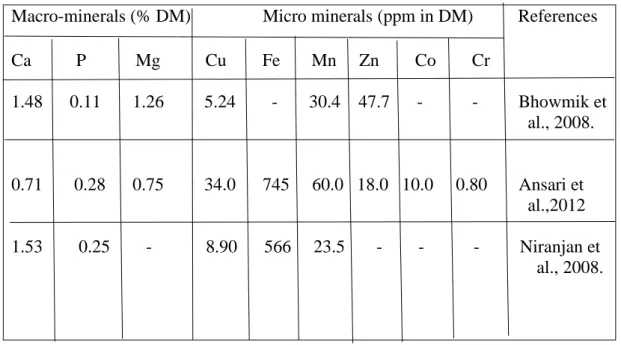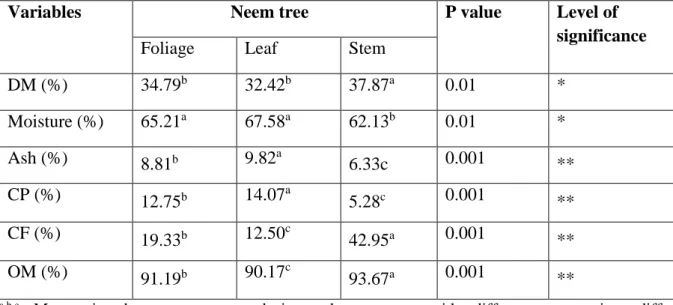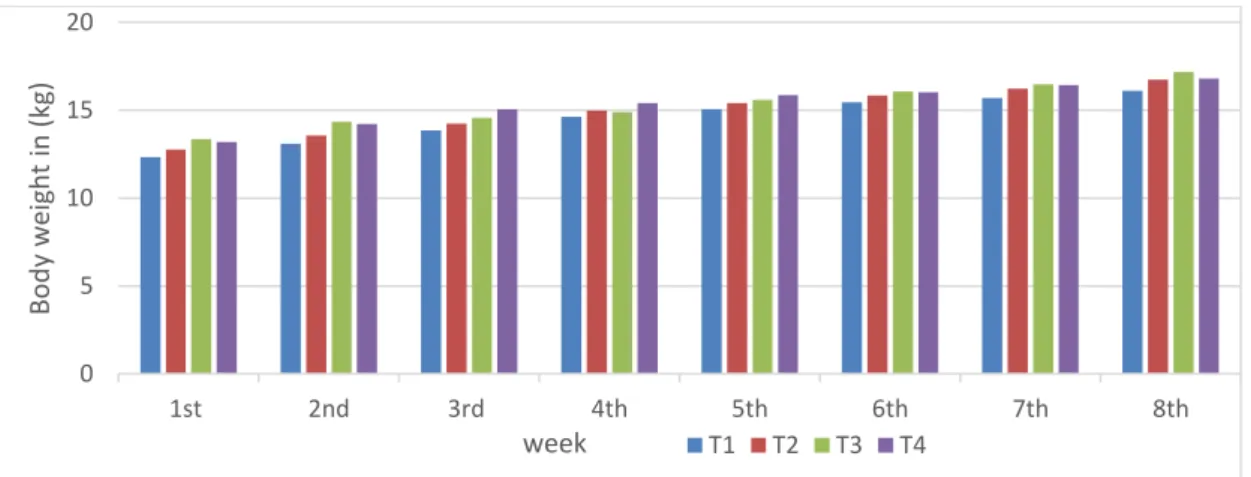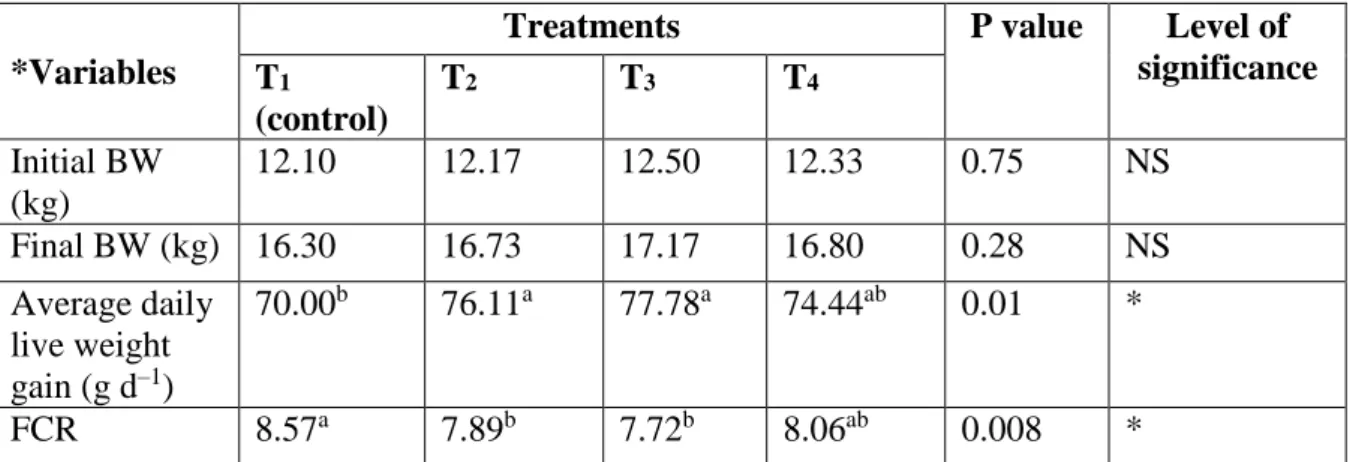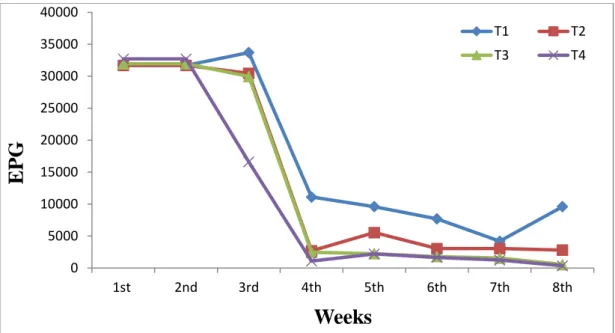This study was conducted to evaluate the effect of Azadirachta indica (neem) hybrid leaves as a substitute to concentrate on the growth and anthelmintic properties of indigenous sheep. After the completion of the quarantine period, twelve indigenous male sheep with an initial mean body weight of 12 ±1.0 kg (mean ± SD) were randomly assigned to 4 treatments and 3 replications. The live weight of the sheep was determined using a digital scale weekly for up to 8 weeks.
Fecal egg counts were performed using the McMaster egg count technique using a 3 g stool sample per week 2 times for up to 8 weeks. A higher mean daily weight gain and FCR value were found in the neem-fed group compared to the control group. In addition, a drastic reduction in the number of faecal eggs was observed in the T4 treatment fed with tall neem leaves compared to the other treatments.
INTRODUCTION
The Neem plant is believed to be one of the most studied tree species in the world due to its wide range of uses (Girish and Shankara 2008). The Neem tree (Azadirachta indica) is a non-moth-bearing multi-purpose tree belonging to the Meliaceae family. Most studies on neem in animal production mainly focus on its medicinal use, usually as an anthelmintic (Adjorlolo et al., 2016). Thus, farmers are largely dependent on commercial concentrates for livestock production and reproductive performance.
In this incident, a farmer cannot meet the daily need for concentrates for his animals. There is evidence that protein supplements are available at a very high cost in developing countries, so this allowed the use of non-protein nitrogen sources to improve nitrogen deficiency in high-fiber diets, improving digestibility, absorption and availability of nutrients through optimization of the rumen fermentation. Makkar et al., 2007). These tree fodders not only provide nitrogen, energy and micronutrients, but also have many other advantages, such as easy accessibility for farmers, their laxative effect on the digestive system, low rumen nitrogen degradability and the provision of dietary variety (Dida et al. ., 2019).
To investigate the optimum ratio of Azadirachta indica (Neem) leaf and concentrate mixture for maximum weight gain of small ruminants.
REVIEW OF LITERATURE
- Chemical composition of neem leaves
- The nutrient profile of neem leaves
- Anti-nutritional factors of Neem leaves
- Acceptability of neem leaves by a livestock farmer
- Anthelmintic properties of Neem leaves
- Effect of Neem leaves on growth and production of Animals
Some anti-nutritional factors such as triterpinoid derivatives (Azadirachtin, nimbidin) (Dida et al., 2019), tannins, phenolic compounds and oxalates have been identified in neem leaves and this limits their use as livestock feed (Adjorlolo et al., 2016) . The tanin concentrations in neem leaves are lower than that of ipil ipil, which will depress feed intake (Niranjan et al., 2008). No available information has been found on the effects of anti-nutritional factors of neem leaves in ruminants.
Some reports suggest that no negative effects of neem have been found as feed for ruminants, and birds even in monogastric (Adjorlolo et al., 2016). However, there is a widespread belief that ruminants do not accept neem leaves because of the bitter taste. But Neem leaves have been reported palatable to sheep (Chandrawathani et al., 2006) and also to goats (Seresinhe and Marapana 2011).
In this study, it was found that the sheep were hungry and when powdered neem leaves were mixed with the concentrate mixture, the sheep readily accepted it. Neem leaves, seeds, bark, roots, fruits and oil have been used medicinally to treat various diseases, especially in Indian Ayurvedic medicine, homeopathic medicine (Tiwary et al., 2014). Aqueous extracts of neem leaves and bark inhibited nematode egg hatching (Yakubu et al., 2006).
The presence of active compounds in neem leaves showed parasiticidal activities against various worms (Amin et al.). Since most of the research shows that neem leaves are primarily effective against nematodes, the potential of neem leaves as a natural anthelmintic agent should be recognized. In ruminant diets, neem leaves can replace 50% of soybean meal without impairing feed intake, dry matter and fiber digestibility, and body weight gain (Paengkoum et al., 2010).
In another study, 30% of the mustard straw was replaced by neem leaves as the intake of dry matter and crude protein was raised to comparable amounts and the synthesis of volatile fatty acids also increased at the same time. A sole diet of neem leaves offered to goats established a high voluntary intake of 3.12% of body weight (Bais et al., 2002). So in conclusion, Neem leaves can be fed as a supplement to animals to increase feed intake and diet quality.
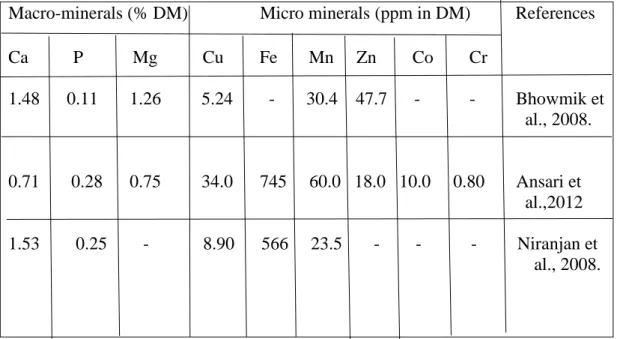
MATERIALS & METHODS
- Study Area & Period
- Preparation of Neem leaf meal
- Collection of Neem leaves
- Grinding & Storage of leaves
- Chemical analysis of Neem leaves
- Experimental Design
- Preparation of Shed
- Collection of experimental Sheep
- Management of experimental sheep
- Feeding & Watering
- Housing
- Determination of growth performance
- Determination of live weight
- Determination of average daily live weight gain
- Determination of FCR
- Laboratory Analysis for fecal egg count
- Direct smear
- Sedimentation
- Simple Tube Floatation
- McMaster egg counting method (simple floatation)
- Statistical analysis
The proximate analysis of the samples (neem leaves) for moisture, total ash, crude fiber, crude protein was carried out in triplicate using methods described by AOAC (AOAC, 2005). The sheep and goat shed of Chattogram Veterinary and Animal Sciences University was used for this study. During this quarantine period, the sheep were offered grass and small amounts of concentrate.
At the end of the quarantine period, the sheep were randomly assigned to four dietary treatments. To evaluate growth performance, live body weight of sheep was determined using a digital scale 1 day per week up to 8 weeks. Average daily weight gain represents the average amount of weight an animal gains each day over a given period of time.
Daily faecal samples (2 days/week) were collected from each animal in the morning and this continued for 8 weeks. These samples were subjected to the McMaster faecal egg count technique, using 3 g of individual faecal samples (Chandrawathani et al., 2019). The faeces sample was first screened by direct staining, sedimentation and flotation techniques to confirm the presence of eggs in the sample before proceeding to the McMaster egg count technique.
A small amount of stool sample and a few drops of water took a microscopic slide and mixed it thoroughly. The debris is then discarded from the slide and a cover slip is placed on the liquid portion and then examined on the microscope. After that it was allowed to settle for 10 minutes and remove the supernatant and collect a few drops of the sediment with Pasteur pipette and place it on a slide and then examined microscopically.
First, take a small amount of stool sample (about 2gm) and add 10ml of floating fluid (saturated sugar solution) in a container and mix it thoroughly. After that, the suspension is poured into a tea strainer and poured into a test tube to the top leaving a convex surface and carefully put a lid slip on the surface. Carefully lift the coverslip from the tube, together with the drop of liquid adhering to it, and immediately place the coverslip on a slide and examine the slide microscopically.
The analysis of variance was performed on the feed intake data, growth performance and direct analysis using the one-way ANOVA in the SAS 9.2 software (2007). The differences in the means will be compared by Duncan's multiple range tests at the 5% level (P<0.05).

RESULTS
Chemical composition different parts of Azadirachta indica (Neem)
Effect of dietary Neem foliage on growth performances of sheep
Effect of dietary Neem foliage on fecal egg counts of sheep
DISCUSSION
On the other hand, in some studies (Chandrawathani et al., 2006) found that there was no statistical difference in faecal egg count on sheep, but reported that the number of worms was less in animals fed fresh neem leaves. This study similar to (Khadijah et al., 2005) and (Wong et al., 2005), found in both studies that fresh neem and pelleted neem showed no significant difference in faecal egg counts compared to control sheep, although the mean faecal egg counts were higher in control group. Sometimes there can be a problem finding trematode eggs on faecal egg count using the McMaster egg count method (simple drift).
The addition of neem leaves to the diet of sheep showed a positive effect on growth. In addition, neem leaf has also been observed to have a positive effect on reducing parasite load in sheep. But no significant result was found in case of differences in body weight of sheep.
However, further study is recommended with large number of sheep to draw final conclusion about neem leaves feeding. Potential contribution of neem (Azadirachta indica) leaves to dry season nutrition of ruminants in West Africa. Effect of the levels of Azadirachta indica dried leaf meal as a phytogenic feed additive on the growth performance and hemato-biochemical parameters in broilers.
Effect of feeding different ratios of pigeon pea (Cajanus cajan) and neem (Azadirachta indica) leaves on feed intake, digestibility, body weight gain and carcass characteristics of goats. Evaluation of local tropical plants by in vitro rumen fermentation and their effects on fermentation end products. Effects of neem (Azadirachta indica) and leucaena (Leucaena leucocephala) feed on digestibility, rumen fermentation and nitrogen balance of goats fed maize silage.
Effect of the inclusion of tree leaves in forage on nutrient utilization and rumen fermentation in sheep. In vitro anthelmintic activity of Neem (Azadirachta indica) plant extract against Haemonchus contortus third instar larvae from goats. Comparative efficacy of albendazole (Endokil) and neem (Azadirachta indica) leaf extract against haemonchosis in sheep.
Effect of Azadirachta indica and Annona reticulate leaves as natural anthelmintics and their effects on zebu cow performance under subsistence farming conditions in Bangladesh. In vitro anthelmintic efficacy of neem (Azadirachta indica) neem (Azadirachta indica) leaf, stem and root aqueous extracts against nematode.
